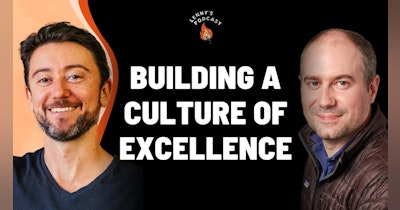Arc and the metrics they use to track growth ▶️
- What Arc is: To the average person, it’s just a simple, best-in-class browser. The true inspiration for it was the belief that the web browser is a new form of computing, and browsers should “feel” good.
- Arc obsesses about one metric: How many people come to Arc at least 5 days a week? Tracking the growth and success of Arc is by measuring how many people use it at least five days a week. It captures retention, engagement, and growth, and is almost impossible to game.
- Arc looks at improving retention cohort by cohort. Arc evaluates if the number is improving from cohort to cohort instead of focusing on absolute numbers. The company boasts a significantly high percentage of users who return to the app on the 5th (D5) and 7th (D7) days after their initial interaction, demonstrating successful user engagement.
Josh’s product-building philosophy, and why he believes in optimizing for feelings ▶️
For example, at Facebook, Josh remembers obsessing over the metric of how many times people shared something. Now, with this new way of feeling product building, he would have instead asked, “Do we think people feel closer to their friends and family?”
- Optimize for feelings. Think about how you want to make someone feel on the other end of your software. Focus on evoking feelings for your software, such as joy, fast, feeling organized, or focused, etc. The Emotion Wheel by the Junto Institute is a popular catalog of emotions you can think about optimizing for.
- Disney and Apple prioritize evoking strong emotions in customers, with Walt Disney and Steve Jobs focusing beyond numbers when creating Disneyland and the iPhone/Mac, respectively. Lots of modern products, like Superhuman, leverage game design to optimize for emotions.
- Focusing too much on metrics can leave a lot on the table and will make people feel more connected with the product. Numbers are a great way, to be honest with yourself about how you’re achieving what to do, but at the moment of creation, they might not help you as much as feelings. Optimizing for only metrics or feelings might be deeply flawed; you should consider both. Josh thinks Silicon Valley has over-optimized for metrics and less for feelings so far.
- For example, Arc’s Peek feature (which lets you open a link without opening a new tab in the browser) was created with the emotion of making the user feel light, airy, effortless, and fast.
Culture for rapid shipping ▶️
- Arc ships quickly because of its values. Josh believes values let them ship quickly, which he talks about in his post on Notes on Roadtrips.
- 3 core values
- Hiring people who show up with “heartfelt intensity,” which is a variety of intrinsic motivations—the drive underneath it all that makes them tick. It’s found in people who have a strong passion and desire to prove something. With such people, if you give them something important to work on, you can just get out of the way.
- Assume you don’t know, so you’ve got to get going. Arc hired someone who built the first version of Google Chrome, and they also embody a beginner’s mind of “I’ve no idea what should happen.”
- Start by asking what could be. For example, with the Peek feature, the team didn’t just want to solve the problem of context switching but, in an ambitious vision, try to make it feel like a sheet of paper, blurring the line between native and web software.
- Shipping new features quickly without PMs. They don't have a formal process such as a PRD or meetings to specify the right feeling to shoot for, but instead the members of the team have a long working experience together, which makes it easier to decide what kind of feeling to aim for. They don’t have traditional PMs. This is discussed further below.
“Notes on Roadtrips,” a doc about values ▶️
- Coming up with values. The Browser Company allowed its culture to inform its values without explicitly telling anyone what those values were. By asking employees how they were doing, Josh slowly noticed the same traits kept coming up. To share these values, the approach taken was to make a fictional road trip story that would feel less like propaganda. It took talking to people one-on-one without any surveys to extract these. “Almost every single value was something someone on the team had said.” Putting it in a road-trip essay form took a long time.
- Other values: You’re doing it for the crew when you’ve got to swarm: emphasizes working together as a team and understanding the importance of having everyone on board in order to move quickly and be effective. Other values include “Making them feel something”—motivates the team’s work to have an emotional impact on users, to make it feel more tangible and impactful.
How Josh is able to hire such amazing talent ▶️
- Intentional when hiring: For Josh, looking back on his career, it was just groups of people and working with them that was most memorable. He wants to build an organization that lets his team feel that.
- Prioritizing team, because the company is a product: Josh views the product as the company, ultimately leading to prioritize the team. In that way, The Browser Company is not a browser company but a dream team of people that Josh loves working with.
- Interviews: The goal of interviews for Josh is to convince candidates not to join the team. He tries to answer everything they want to know by being very transparent, assuming most people don’t want to work there.
- Celebrate the team publicly and share accomplishments: They have the mandate to celebrate their team when they hire a new member, ship a project, and when they do something incredible. Publicly showing appreciation is a key tactic to engage their team and create a tumbleweed of people wanting to join.
- Transparency as a way to connect with people: They are public and open about what’s going on inside the company. They bring cameras into board meetings, share actual projects, and encourage discussion about successes that may have been delayed. Sharing information publicly builds trust and creates a sense of safety and community with the team.
The good and bad of building in public ▶️
- Radical trust-building: They take a “prototype-driven” approach to being public, and part of that is building radical trust with the public, by allowing people to get to know the employees. Josh (CEO) is hesitant to be too central, but they want people to believe in their team and products to restore the trust broken by other tech companies over the years.
- Prototype-driven culture: They embrace a prototype-driven environment. This means that they are willing to constantly experiment and not be afraid to take risks, even if it means potentially regretting certain strategic moves. They have “odd” teams, such as a membership team and a storytelling team, which aren’t traditionally seen in startups.
Odd teams at The Browser Company ▶️
- The membership team was inspired by the user research team at Facebook. User research at Facebook often felt like a service relative to product engineering/design, but The Browser Company strives to go deeper in understanding and serving their users, without being limited by terms like “customer service” or “user research.”
- The membership team has a full-stack responsibility to understand users from the moment they first interact with the product to their ongoing needs, whether it’s learning to use a feature, reporting a bug, or providing input on a new release, ensuring a seamless user experience.
- The storytelling team focuses on communicating their story to people outside their product—to investors, members of the press, general members of the public, and others. They focus on telling their story to people holistically in what is called a “full stack.”
Why The Browser Company doesn’t have traditional PMs ▶️
- Josh views PM-ing not as a team but as a role on a project and effort, and depending on the project, different types of people should be the PM. A PM is flexible, adaptable, and tailored to specific project requirements; this could, for example, involve assigning infrastructure engineers or someone from the membership team as the PM for different projects.
- They believe the skills and tasks of a PM can be performed by anyone they hire, and prefer to hire multi-disciplinary individuals with a mindset focused on making things and adapting to different roles as needed.
- Example: Rebecca, who has experience in data science, behavioral psychology, and software engineering, effectively plays a PM role but is not limited to that title or specific tasks.
A case for adding PMs ▶️
- Good engineers or designers may initially take on PM responsibilities but eventually may find it inefficient and seek to hire someone who loves the role. A good PM can make a big positive impact on a team’s happiness and productivity, while bad PMs add unnecessary complexity.
- Josh remembers Evan from Snapchat had said the company would never hire PMs, but they eventually ended up hiring them. So he thinks something similar might happen to them. A potential path for The Browser Company could be evolving the data team and adding technical PM roles if needed.
Airbnb’s Snow White project and Browser Company’s storytelling team ▶️
- Lenny: “The storytelling team makes me think about Airbnb’s video team. A lot of people were joking internally for years that the videos put out in the early days accounted for like half their market cap, because they’re so good and you’re just like, ‘Oh my god, I want to go to an Airbnb.’ They just make you feel so much.”
- The idea of the storytelling team was to hire radically different archetypes. For example, Josh Lee, who he met as an intern at Facebook, has been making indie films for a few years now. Ellie has been a reporter at Vox, etc.
Beauty is in the 👁️ of the browser
— The Browser Company (@browsercompany) February 16, 2023
Presenting... Peek! pic.twitter.com/ONdQ3Ip4Ko
- You can read more about Airbnb’s storyboarding and Snow White metaphor here.
The shift to cloud computing ▶️
What is missing is an interface and a set of capabilities and APIs that make web-based experiences as immersive, rich, and powerful as native experiences.
- The experience gap in native vs. web, and Josh’s vision to fix it: The Browser Company aims to build an internet computer that could replace the default web browser, much like the iPhone did for cellphones. They believe in the potential of the web as a development platform due to its accessibility, affordability, and democratic nature. However, there’s an experience gap where native software feels superior to web-based platforms, which needs to be addressed for the future of internet computers.
- Dominant tech companies have incentives to keep the experience gap: Dominant tech companies like Apple and Google have incentives to maintain the experience gap between native software and web-based platforms. They benefit from the app store and play store taxation (30%), and Google prefers indexable search engine content, and hence doesn’t emphasize a lot of Chrome extensions. The Browser Company envisions a future where internet computers offer immersive and rich experiences through new interfaces and powerful capabilities.
- An open development platform for innovation: Arc plans to create an open development platform with powerful capabilities and APIs, alongside new internet computer interfaces. By offering developers more freedom and resources, they hope to foster innovation and close the experience gap between native and web-based platforms.
This is a human edited summary of the podcast episode with Josh, by Gaurav Chandrashekar (@cggaurav, productscale.xyz). To listen to the full episode, go here.








